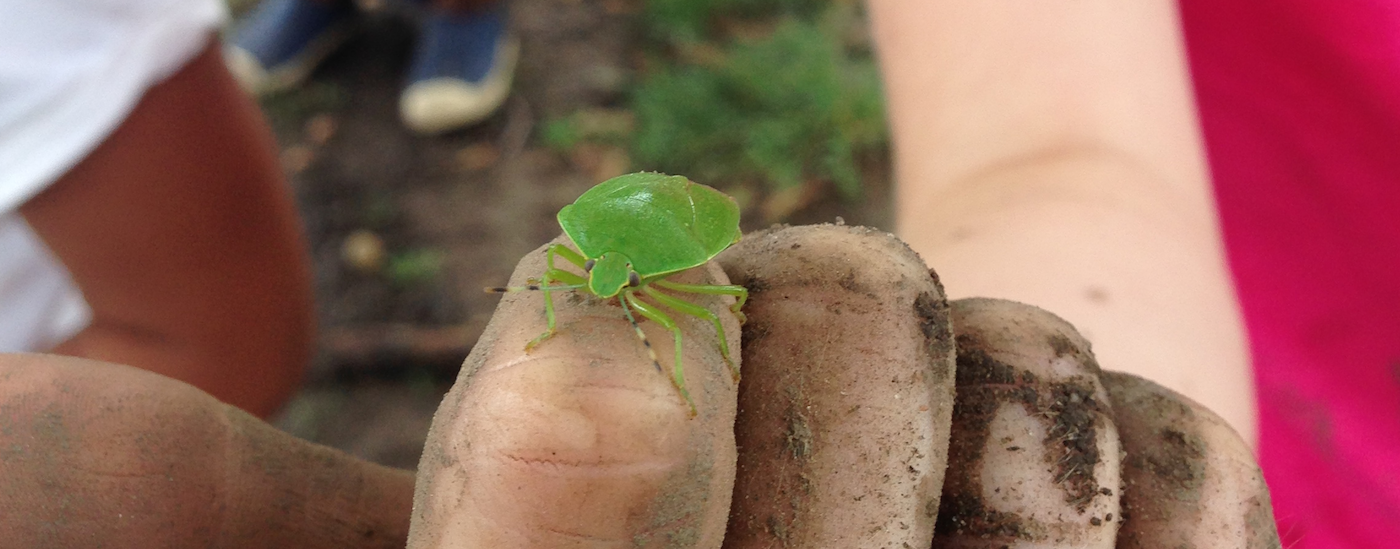Make a Bindle
-
Age: 0 to 8+
-
Time: Under 1 hour
-
Materials: pillowcase; fabric markers; stick
- Skills: Curiosity, Naturalist, Behavioral Schema, Fine Motor, Self Reliance
How many times have you been out with your kids for the day only to find that they've managed to fill their pockets and yours with special rocks, flowers, sticks, and, my personal favorite: dead bugs! Almost every child in every culture goes through (or maintains) a phase in which he loves to put objects in and out of containers and, better yet, move those contained objects around. Although it can seem a little silly and even tiresome to us, the desire to find, collect and cart treasure from one place to another is a universal pattern in kids' behavior and, it turns out, brain development.
We also know that kids need to learn not to remove objects from our most treasured landscape, so we need to honor their drive to collect but also help them build a practice of leaving no trace. And it is possible to walk that line. You just need the right tool and habits. So, we've found that making a "bindle" (i.e. a sack on a stick you know from cartoons) is a great way to harness kids' drive to amass goodies while also making kids independent and freeing us of unwanted guests in our pockets. Take the bindle with you or keep it in the bottom of your pack or stroller, just get a new stick every time. Give kids the chance to notice the amazing variety of things that fall, drop, sprout and blossom at different times and in different places. This way to cart goodies around will be all the rage with your kids.
The Guide
- Prep bindle-making materials: You'll need one pillowcase per bindle, and somehow we can always find an old pillowcase that costs us nothing or find some on the cheap. Cut each pillowcase in half, using the half that is still a sack for a bindle (you can use the rest for making wind flags, nets or other fun things). Cut a slit about 6-8 inches in length down each side of the sack.
- Decorate the bindles: Once you have your 1/2 pillow case, let kids decorate it. We've had good luck with using fabric markers, dot paints and dry erase crayons.
- Find a stick: Guide kids to find a stick long enough to go from their hands and about a foot over their shoulders.
- Tie on the sack: Tie the bindle sack to one end of a stick making two knots by using the slits you cut on each side of the sack.
- Put the bindle to good use: Make sure kids understand how to slip an object into the bindle. Then, let kids start exploring, gathering treasure, and carting goodies about.
- Teach leave no trace: Before they start collecting, be explicit that we only gather objects on the ground (i.e. we don't pluck from trees or plants). Before you leave the green space in which you are playing, leave the nature treasures you've gathered where they belong—in the park. We like to say that the animals and plants in the park need those objects, and say "here you go" to them as we sprinkle them back to the earth.
- Keep it handy: Leave the stick in the forest or park, but tuck the bindle in your bag, backpack, car, stroller, etc. so it's around next time you head outdoors.
Why is this activity great for kids?
Once kids make a bindle, you have a super portable tool to use to gather materials for making an endless number of things. Decorating, tying, filling and keeping a bindle sack on a stick all help to develop coordination and fine motor skills. When kids are able to make their own tool out of simple materials, they become master of their own collections and, in turn, develop self reliance. This one also hits several behavioral schema. Filling up the sack and carting things around is the perfect activity to support kids as they develop a brain and body via the transporting schema, while tucking objects into a sack also exercises the enveloping schema. This kind of activity also tends to get kids excited to get out on a hike and can even help keep them happy longer on the trail.




